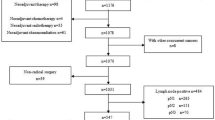Abstract
This study was conducted to evaluate lymph node metastasis as a key prognostic factor in esophageal cancer. Metastatic lesions in lymph nodes were grouped by histological morphology as intracapsular or extracapsular, and the significance of lymph node metastasis was evaluated by relating metastatic lesions to clinical pathologic factors and patient prognosis. In our hospital, 46 of 81 patients who underwent resection of esophageal cancer developed lymph node metastasis. These 46 patients were enrolled in a study analyzing the relationship between the metastatic mode and the clinicopathological factors. The frequency of extracapsular metastasis was significantly high in patients with a profound depth of cancer, three or more metastases, distant metastasis (n3 and n4), or severe lymphatic invasion. The prognosis was significantly worse in patients with extracapsular metastasis, and this tendency was also seen even in patients with three or more metastases, limited metastasis (n1 and n2), or mild lymphatic invasion (ly0 and ly1). These findings suggest that the metastatic mode reflects the degree of esophageal cancer progression and is an important prognostic factor.
Similar content being viewed by others
References
Fujita H, Kakegawa T, Ando N, Kawahara H, Abe O (1985) Quantative and qualitative analysis on lymph node metastasis of carcinoma of the esophagus. J Jpn Surg Soc 86:424–434
Endo T (1992) A research of factors determining the prognosis of patients with esophageal cancer using a multivariate analysis-by Cox's propotional hazards model (in Japanese with English abstract). Jpn J Gastroenterol Surg 25:1191–1200
Kotoh T, Arima S, Inada S, Futami K (1995) A study of lymph node metastases and recurrence in thoracic esophageal cancer. Med Bull Fukuoka Univ 22:53–60
Kotoh T, Arima S, Inada S, Futami K (1997) Prognostic factors of patients with thoracic esophageal cancer using a multivariate analysis. Med Bull Fukuoka Univ 24:69–81
Japanese Society for Esophageal Diseases (1992) Guidelines for the clinical and pathological studies on carcinoma of the esophagus, 8th edn
Yoon T (1997) Mode of metastasis of Dukes C colorectal cancer in lymph nodes. J Jpn Soc Coloproctol 50:331–338
Izuo M, Akahane K, Okano A, Kawai T (1973) The significance relation to hematogenous metastasis of blood vessel invasion with lymph node in breast carcinoma (in Japanese). Igaku no Ayumi 87:490–491
Teel P, Sommers SC (1964) Vascular invasion as a prognostic factor in breast carcinoma. Surg Gynecol Obstet 118:1006–1008
Kister SJ, Sommers SC, Haagensen CD, Cooley E (1966) Reevaluation of blood-vessel invasion as a prognostic factor in carcinoma of the breast. Cancer 19:1213–1216
Fridell GH, Betts A, Sommers SC (1965) The prognostic value of blood vessel invasion and lymphocytic infiltrates in breast carcinoma. Cancer 18:164–166
Author information
Authors and Affiliations
Rights and permissions
About this article
Cite this article
Tachikawa, D., Inada, S., Kotoh, T. et al. An evaluation of malignancy and prognostic factors based on mode of lymph node metastasis in esophageal carcinoma. Surg Today 29, 1131–1135 (1999). https://doi.org/10.1007/BF02482260
Received:
Accepted:
Issue Date:
DOI: https://doi.org/10.1007/BF02482260




